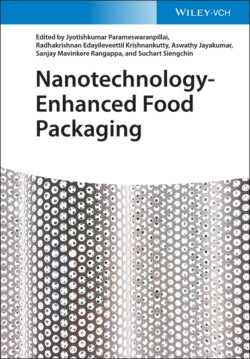Читать книгу Nanotechnology-Enhanced Food Packaging - Группа авторов - Страница 40
2.2.5.1 Soy Protein
ОглавлениеThe commercial soy protein is a by-product obtained from the soy oil extraction, being available as soy protein concentrate (SPC), soy protein isolate (SPI), and soy flour. SPC and SPI differ mainly by protein and carbohydrate contents. According to Koshy et al. [94], full soy flour and SPC showed carbohydrate content (34% and 18%, respectively) and protein content for full soy flour (56%), SPC (65%), and SPI (>90%).The full fat soy flour is produced by grinding soybeans into fine powders, while the SPC is prepared by defatting and removing of water-soluble carbohydrates from soy flour. Finally, the SPI is a highly refined soy flour and free of the most nonprotein components, fats, and carbohydrates [94].
Table 2.4 Films and coatings based on collagen and gelatin for food packaging applications.
| Components | Production approach | Mains results | References |
|---|---|---|---|
| Gelatin/mint essential oil | Dip coating | Coatings with antimicrobial properties used to extend the shelf life of strawberries | [78] |
| Gelatin (PSa))/ starch/acerola powder | Casting | Active films containing acerola compounds | [79] |
| Gelatin (SSb))/TiO2 | Casting | Films with antimicrobial activity against E. coli and S. aureus | [80] |
| Collagen/lysozyme | Dip coating | Coatings with antimicrobial activity against psychrotrophic bacteria used to extend the shelf life of fresh salmon fillets | [81] |
| Collagen (FSc))/sodium alginate | Casting | Biodegradable films with better structural organization | [82] |
| Gelatin (FSc))/cellulose nanofibers/palmitic acid | Casting | Films with improved physicochemical properties | [83] |
| Collagen/nisin | Casting | Films with antimicrobial activity against L. monocytogenes, S. aureus, and Lactobacillus, used to package ready-to-eat sausage | [84] |
| Gelatin (PSa))/chlorophyllin | Drying tunnel | Films with antimicrobial activity against L. monocytogenes and E. coli., used to package bologna slices | [85] |
| Gelatin (FSc))/ZnO/chitosan nanofibers | Casting | Films with antibacterial activity used to package chicken fillet and cheese | [86] |
| Collagen/chitosan/pomegranate peel extract | Casting | Films with antimicrobial activity against B. saprophyticus, B. subtilis, S. typhi, and E. coli | [87] |
| Collagen (LWd)) hydrolysate | Spraying nozzles | Coatings used to improve the growth of peas, soybean, broad bean, and rape seeds | [88] |
| Gelatin (e)BB and f) BC)/mint essential oil | Casting | Coatings with antifungal activity against B. cinerea and R. stolonifera for fruit application | [89] |
| Gelatin (FS c)) hydrolysate | Dip coating | Films were used to extend the shrimp shelf life, reducing microbial growth and lipid oxidation | [90] |
| Collagen from cowhide | Casting | Films with better structural organization | [91] |
| Gelatin (FS c))/squalene | Casting | Biodegradable packaging used to package fried fish crackers | [92] |
a) PS: porcine skin.
b) SS: shark skin.
c) FS: fish skin.
d) LWs: leather wastes.
e) BBs: bovine bones.
f) BC: bovine cartilage.
The soy protein consists in a mixture of albumin and globulin proteins, which have an isoelectric point from pH 4.5 to 4.8 and are classified in four main categories: 2S, 7S, 11S, and 15S fractions, where S corresponds to Svedberg units [95, 96]. The 7S (β conglycinin) and 11S (glycinin) globulin proteins constitute 35% and 52% of the soy structure, respectively, while the 2S and 15S albumin proteins only correspond to 8% and 5% of the soy structure, respectively [97]. SPI has an ability to form films softer and more transparent than other soy products [96]. Its films also exhibit higher gas barrier than lipids and polysaccharides-based films [94]. However, the complexity of globular proteins decreases the flexibility of chains, which results in the formation of fragile and stiff films and coatings [97].
In order to improve the mechanical properties of soy-based biomaterials, soy proteins have been associated to other materials to form composites since their structure exhibit polar functional groups as hydroxyl, carboxyl, and amine that facilitate its chemical and physical modifications [97] (Table 2.5). These groups are distributed along 18 amino acids composing the soy protein structure including arginine, lysine, leucine, cysteine, phenylalanine, tyrosine, aspartic, and glutamic acid [94, 97].
